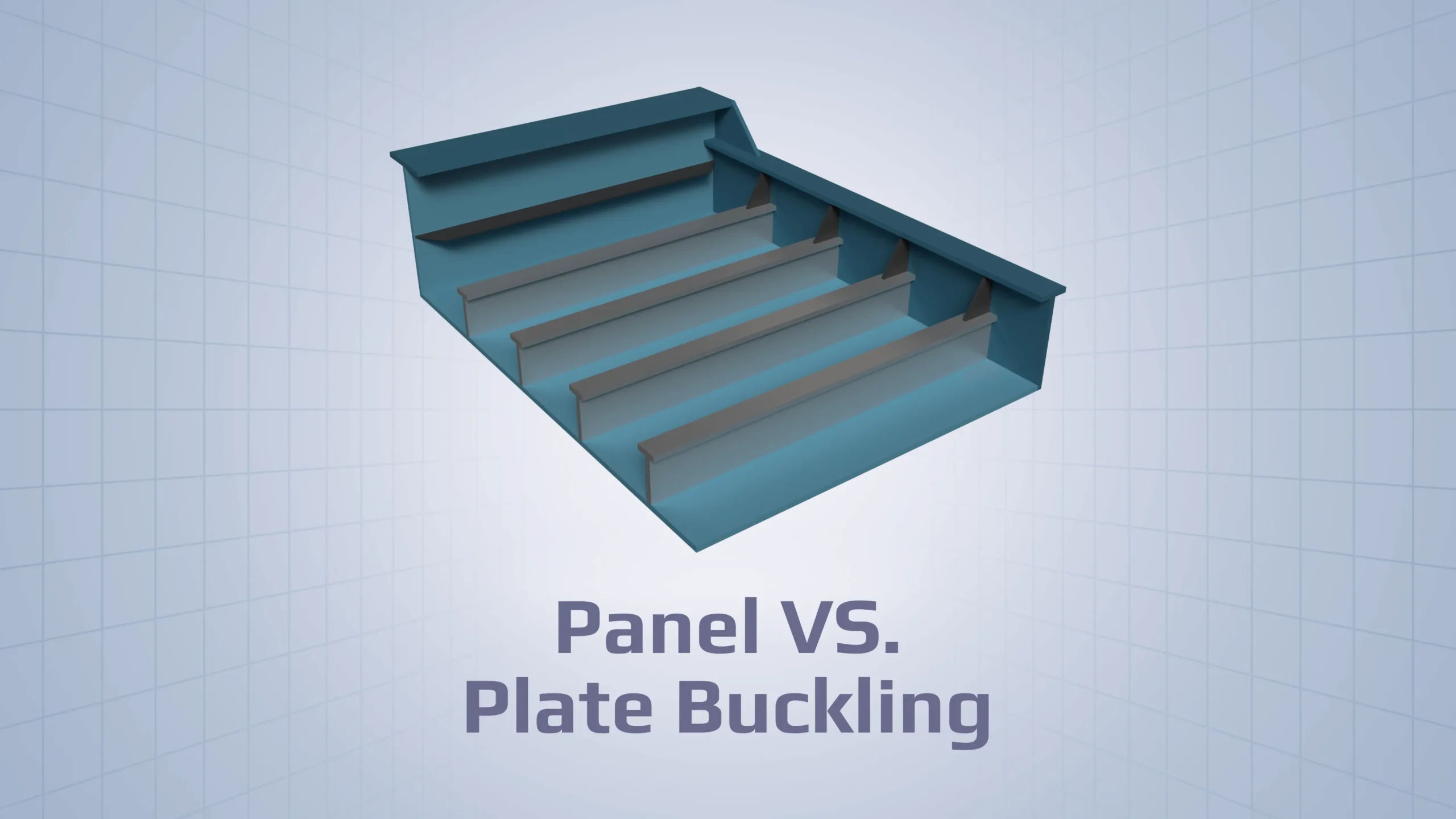
Running a quick “plate buckling” check on a mesh seems enough , but it rarely tells the whole story. In real ships, offshore units, and steel frameworks, plates don’t exist in isolation. They form panels, bounded by stiffeners, girders, and frames. These boundaries define the actual geometry, support conditions, and buckling behavior.
Ignoring this distinction can lead to misleading safety margins and non-compliant results. That’s why engineers need to think in terms of panel buckling, not just plate patches.
This article breaks down the difference between plate and panel buckling, explains why boundaries matter, and shows how modern FEA and automated panel recognition ensure checks aligned with standards like Eurocode 3, DNV, and ABS.
Image: Diagram showing plates, brackets, and griders
Before discussing workflows, let’s clarify the difference between what engineers call a plate and what they actually verify as a panel.
Image: Plates visualization
Image: Panels visualization
When verification is done, the assumed supports rarely match the real behavior of the structure. This can lead to:
By moving from isolated plate assumptions to panel-based checks, verification reflects how the structure is built and supported. This ensures results are consistent, realistic, and compliant with standards like EC3, DNV, and ABS.
In real designs, a panel is never just an arbitrary patch of mesh—it’s the area of plating enclosed by supporting members.
These members act as boundaries, and they play a decisive role in how the panel resists buckling. Typical boundaries include :
Once these boundaries are set, the panel dimensions (a × b) and aspect ratio are defined. Just as important are the edge conditions along each boundary. A panel edge may be:
These conditions directly influence the buckling coefficient, which determines the panel’s resistance. For example, a clamped edge provides more restraint than a free edge, increasing buckling capacity.
Below are how the main standards treat buckling of plates vs panels — what they require you to check, how they guide you to define boundaries, stresses, and when you switch from “flat plated structure” to “shell / curved” rules.
EC3 (Eurocode 3 — EN 1993-1-5)
Effective area: reduce the plate width or section capacity when local buckling occurs.
Reduced stress: keep full section but limit allowable stresses ; practical for FEA workflows.
ABS (Guide for Buckling and Ultimate Strength Assessment)
Panel recognition is a crucial step in moving from isolated plate checks to proper panel buckling verification. SDC Verifier’s tool Panel Finder automates this process, helping engineers identify panels, plates, and stiffeners from an FEA model with minimal manual work.
How SDC Verifier Helps:
1. Import the FEA model.
Panel Finder scans the model and automatically detects sections (X, Y, Z, or custom/inclined planes). Each section contains plates, stiffeners, and panels.
Image: FEA model
2. Recognize panels.
Image: Recognizing panels
a. A panel is a set of plate elements bounded by stiffeners or other plates.
b. Plates are grouped according to geometry, edges, and thickness.
Image: List of recognized plates
c. Stiffeners are line or plate elements supporting the panel to prevent buckling.
d. The tool calculates panel dimensions (length × width), orientation, and geometric , preparing them for checks.
3. Check plates and stiffeners.
a. Plates are logically subdivided for checking purposes — based on stiffener layout, thickness changes, or geometry attributes — without altering or remeshing the underlying FEA model
b. Stiffeners are recognized as straight or curved, with
c. Dummy stiffeners or borders can be added to account for partially connected elements.
Image: Model showing plates
4. Run panel buckling checks.
Using the identified panels and boundary conditions, you can perform EC3, DNV, or ABS checks and review utilization ratios. Results reflect the full structural behavior, not just a small mesh patch.
Image: Model after buckling check
5. Visualization and reporting with Report Designer.
a. Highlight panels, plates, and stiffeners directly in the model.
b. Colors, labels, and IDs can be displayed to quickly review recognition results.
c. Dimension values, plate orientation, and stiffener distribution can be exported or plotted for documentation.
Image: Results of calculations
Tip: Update panel recognition whenever the model changes — for example, if geometry, supports, or stiffeners are modified. Otherwise, re-running recognition isn’t required.
Watch our YouTube video guide for more detailed overview of Panel Finder.
Discover how SDC Verifier automates plate and stiffener recognition:
Video: YouTube “Panel Finder How To | SDC Verifier”
Even experienced engineers can fall into pitfalls when performing plate and panel buckling checks. Here are the most frequent mistakes and how to prevent them:
Tip: Always analyze the full panel bounded by stiffeners or girders.
Tip: Always perform checks using code-compliant load combinations to ensure realistic and conservative results.
Tip: Include all significant cutouts and account for support restraints when defining panels.
Tip: Keep plate/panel slenderness calculations separate from member checks.
Tip: Verify that FEA principal stress directions align with panel axes before running checks.
Tip: Use shell-specific standards (e.g., DNV C202) for curved plates or shells.
Following these guidelines ensures buckling verification reflects real structural behavior and complies with EC3, DNV, or ABS rules.
Consider the same area of plating on a deck or hull:
Outcome: The results differ significantly. In some cases, the patch check may appear safe, while the full panel check reveals potential buckling risks. This clearly shows why boundaries matter in structural verification.
Plate buckling checks may give a quick impression, but only panel buckling analysis reflects the true structural behavior of stiffened plating in ships, offshore units, and steel frameworks. By considering real panel boundaries, stiffener spacing, aspect ratios, and edge conditions, engineers can avoid misleading results and ensure compliance with EC3, DNV, and ABS standards. Modern workflows, supported by automated panel recognition, make this process efficient and reliable—bridging the gap between FEA models and code-based verification.
Stay updated with the latest in structural verification, engineering insights, and SDC Verifier updates.